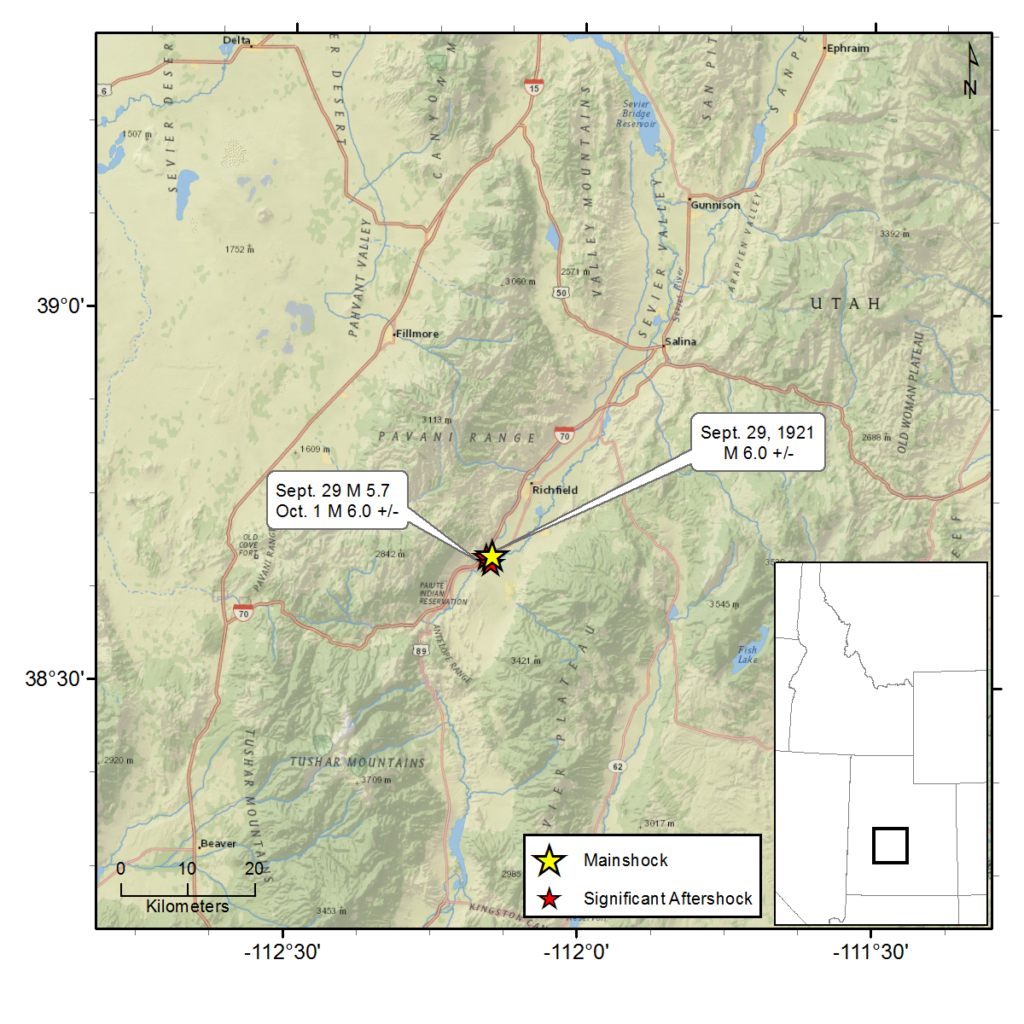September 29, 1921 - Elsinore, UT (series) - M 6±
Thursday, September 29, 1921 at 7:12 a.m., a magnitude 6 ± earthquake struck Elsinore, Utah. It was followed by two significant aftershocks: a magnitude 5.7 aftershock at 7:03 p.m. the same day, and a magnitude 6 ± aftershock two days later on Saturday, October 1 at 8:32 a.m.
September 29 Main Shock and Aftershock
There was widespread damage to buildings in the city of Elsinore, including: broken or sunk foundations, downed chimneys and gables, cracked walls and fallen plaster, and damaged roofs and ceilings from falling bricks and cement. Nearly every building the city was damaged . Damage was particularly severe for stone, brick and adobe buildings. Frame structures faired somewhat better. Firewalls at the newly built schoolhouse collapsed into the schoolyard. The walls and roof of the school were badly damaged.
No deaths occurred, but there were many near misses when people ran out of buildings while bricks and other building debris was falling.
In the town of Monroe, approximately five miles southeast of Elsinore, there were reports of cracked walls in several buildings. Goods were shaken off store shelves. A pipe trench caved-in. The Monroe hot springs water turned red.
Clouds of dust were observed in nearby canyons as large rocks and cliff sections were shaken loose and tumbled down to the canyon floor.
A significant aftershock later the same day worsened conditions of buildings already damaged earlier that morning.
October 1 Aftershock
The magnitude 6 ± aftershock on October 1 caused some new structure damage as well as worsening the condition of already damaged buildings.. Walls and roofs collapsed. A paint store in Elsinore that had been severely damaged on September 29 had its storefront collapse onto the sidewalk on October 1.
An Elsinore woman was injured from falling plaster when a chimney fell onto the roof. Nearly all residents living in stone or brick houses slept outside or with neighbors who lived in frame houses. People moved household furniture out into their yards for protection.
Dust clouds above nearby canyons were observed again as more boulders were dislodged, tumbling down into the canyon floor. Water at Monroe hot springs once again turned red. Surrounding hills displayed great white seams where the earth surface cracked.
Extensive damage occurred to buildings in Monroe. Practically all chimneys were downed or cracked severely. Some homes damaged by the main shock, were damaged so severely on October 1, they had to be torn down. Many Monroe residents slept outside, in barns, haystacks or granaries.
Some damage was reported in Richfield, Central and Joseph, Utah. A Richfield man was injured when he was struck by chimney bricks that fell through a ceiling.
Shaking from the main shock and significant aftershocks was felt from Salina, Utah, in the north, south to Marysvale, Utah.
For additional information about this earthquake:
Earthquake Summary Newspaper Articles Photos
Personal Accounts Additional Resources
Intermountain Seismic Belt Historical Earthquake Project
- 1945 Flathead Lake, MT M5.5
- 1952 Bigfork, MT M5.5
- 1935 Helena, MT (series) M6¼
- 1929 Lombard, MT M 5.6
- 1925 Clarkston Valley, MT M 6¾
- 1959 Hebgen Lake, MT M 7.5
- 1975 Yellowstone National Park , WY M 6.1
- 1947 Virginia City, MT M 6¼
- 1945 Central Idaho M 6.0
- 1944 Central Idaho M 6.1
- 1983 Borah Peak, ID (series) M 7.3

